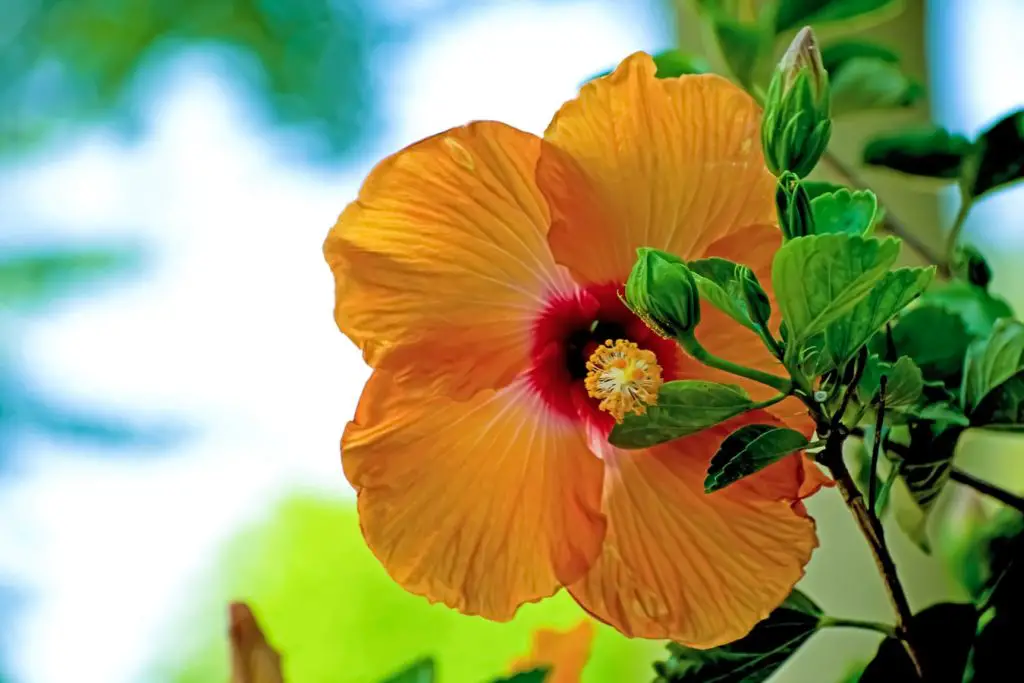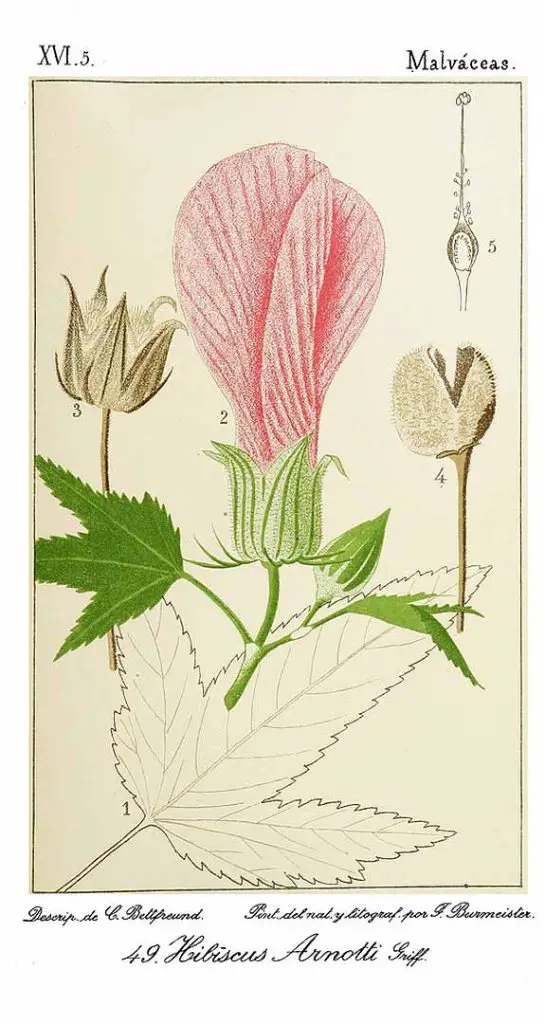Around the world, there are hundreds of flowering plant species known as Hibiscus, many of which are purely ornamental rather than medicinal. The most common of these ornamental varieties is Hibiscus syriacus. Like the rest of its sister strains, syriacus is part of the mallow family.
The hibiscus plant is widely revered by a number of cultures. For instance, the ancient Egyptians reaped the medicinal benefits of hibiscus tea thousands of years ago, drinking the beverage as a sort of all-encompassing elixir. Today, hibiscus tea is a popular beverage for wedding toasts in both Egypt and Sudan and is commonly sold in open-air cafes.
In Hindi mythology, the red hibiscus is considered the symbol of the goddess Kali, who represents death and destruction as well as motherly affection. Hibiscus is also the national flower of Haiti, and the Hibiscus rosa-sinensis has been given the same designation in Malaysia.
Botanical Name: rosa-sinensis
Other Common Names: Hardy hibiscus, tropical hibiscus, rose of Sharon (not to be confused with Hypericum calycinum, which goes by the same name), rose mallow, sour tea, kenaf, rose of Althea, zobo tea, Jamaica sorrel, Karkadé, oseille rouge, pulicha keerai, red sorreland, shoe flower, and Chinese hibiscus.
Habitat: The origin of hibiscus is somewhat unclear, but it was likely first cultivated somewhere in East Asia, probably China, Japan, or the Pacific islands. Madagascar and Hawaii are also likely contenders.
An estimated eight hibiscus plants are the supposed ancestors of the hundreds of varieties around the world. Malaysia’s revered Hibiscus rosa-sinensis is one of the original varieties, along with Hibiscus fragilis (native to Madagascar) and Fiji’s Hibiscus storckii.
Hibiscus is a versatile and hardy plant that grows well in a variety of conditions, including temperate, tropical, and subtropical climates. Both perennial and annual hibiscus plants exist, and they may grow in the form of hibiscus “trees” or shrubs in colder climates that experience true winter conditions.
The largest hibiscus varieties can reach upwards of 8 feet tall, but many varieties are much more diminutive. The hibiscus plant loves full sun conditions and grows best in well-drained loamy or sandy soils that aren’t excessively wet.

Plant Description: Hibiscus blooms, which can reach a diameter of more than 6 inches, are undoubtedly the plant’s most stunning feature. Depending on the variety, hibiscus flowers can be yellow, pink, burgundy, white, lavender, or the Kali-approved vibrant red.
Expect your outdoor hibiscus plants to bloom in mid to late summer but have a short lifespan of only a few days. Under controlled indoor conditions, hibiscus plants may bloom year-round.
Plant Parts Used: Whatever the variety of hibiscus (as long as it’s not strictly ornamental), all parts of the versatile plant can be used. This includes everything from the plant’s bark to blooms, leaves, and seeds.
Hibiscus tea is typically comprised of a mixture of dried leaves, flowers, and calyces. Dark red in color, calyces are the hibiscus flower’s center, which resembles the shape of a cup. Once the calyces dry up, you’ll find a pod of seeds inside the center.
When harvesting dried hibiscus flowers and calyces, take care not to damage the plant. Rather than pulling off a calyce, carefully prune them off the plant using sharpened shears.
Potential Therapeutic Uses and Benefits of Hibiscus
Hibiscus plants enjoy widespread use across the globe. Hibiscus cannabinus, for instance, is widely used in paper-making applications. Further, modern Polynesians are known to harvest the inner bark of Hibiscus tiliaceus, also known as sea hibiscus or hau, and use it to make a sturdy rope.
In Jamaica, where hibiscus is commonly called “shoe flower,” juice from the plant was often used as a shoe polish as well as enjoyed as a beverage.
As our ancestors discovered thousands of years ago, the hibiscus plant also has myriad medicinal benefits. Beverages made from steeped, dried hibiscus are undoubtedly the plant’s most popular application and have been a culinary delicacy for thousands of years
Hibiscus tea is said to improve digestion, thanks to its diuretic properties, and may also relieve menstrual cramps. What’s more, hibiscus tea may serve as a safe and natural energy boost, which in turn helps you become more active and compounds the benefits of your regular exercise regimen.
You may even find that hibiscus tea works better in boosting your energy than caffeine. If that’s the case, hibiscus tea may serve as an effective way to wean yourself off of caffeinated beverages and similar substances.
In addition, hibiscus is popularly used as an herbal remedy for various conditions that include fever, high blood pressure, bacterial infections, poor circulation, and heartburn. Many of us would rather try natural remedies for heartburn relief rather than pharmaceuticals, and hibiscus is an ideal option.
Along with the hawthorn plant, researchers have determined that hibiscus extract shows promise in lowering both blood pressure and cholesterol levels. However, those with high cholesterol may not see as notable a change as those with metabolic syndrome or diabetes.
Interestingly, hibiscus and the hawthorn tree have much more in common than helping to lower blood pressure. Hawthorn has been shown to have a positive effect on the circulatory system, and hibiscus is also widely regarded as an effective circulation booster.
Hibiscus can increase blood flow and is especially beneficial during the winter months when our circulation naturally slows. Poor circulation can lead to serious conditions such as varicose veins and blood clots, but drinking a warm mug of hibiscus tea on a daily basis may help combat reduced blood flow.
Thus, those living with diabetes or obesity should consider making hibiscus tea part of their daily health regimen. That’s because poor circulation can compound the negative symptoms of diabetes and obesity, and can be extremely dangerous.
Most hibiscus varieties are also chock full of antioxidants, which help protect the liver as well as regulate blood pressure. Antioxidants such as hibiscus tea may also help to eliminate free radicals in your bloodstream, improving your overall health as well as your immune system.
In effect, hibiscus tea may improve your overall health even if you don’t have an underlying health condition.
Dosage and Administration
Once a hibiscus bloom wilts and dries out, it will fall off the plant with the calyces still intact. Where brewing hibiscus tea is concerned, this is the preferred part of the plant.
Dried leaves and/or the plant’s easy-to-peel bark can also be used when brewing hibiscus tea, although the leaves and bark may produce a bitter taste. Fortunately, you can easily combat the bitterness of hibiscus using a natural sweetener such as wildflower honey or agave.
Those who dislike tea, in general, can opt to ingest hibiscus in extract form. Hibiscus extract can be taken as-is or added to your favorite beverages.
Generally speaking, you should take a dose of hibiscus extract several times per day, depending on the severity of your symptoms as well as your age, body type, and metabolism.
Possible Side Effects and Interactions of Hibiscus
Hibiscus tea is considered acidic but has not been shown to aggravate acid reflux symptoms. Because acid reflux is caused by a defect in the stomach’s functions, the diuretic properties of hibiscus may actually improve gut health and help relieve acid reflux.
However, as with any herbal treatment, you should discuss any concerns about medicinal hibiscus with your primary healthcare provider. Since hibiscus may help lower blood pressure, individuals with low blood pressure may want to avoid the plant.
Hibiscus may also be unsafe for pregnant or nursing women, possible even inducing a miscarriage. If you’re pregnant or breastfeeding, you should source your herbal tea elsewhere. Opt for ginger root, chamomile, or peppermint tea instead of hibiscus.
It’s also important to note that hibiscus may interact with certain medications. If you’re taking chloroquine to treat or prevent malaria, you should avoid hibiscus.
The herb may also interact with a number of diabetes medications. This is because hibiscus tea may actually decrease your blood sugar, so it should not be used in tandem with medications that have a similar effect. Avoid hibiscus teas and extracts of you’re taking medications such as insulin, tolbutamide, metformin, or chlorpropamide.
Hibiscus may also negatively interact with blood pressure medications and acetaminophen, the brand name of which is Tylenol. If you choose to drink hibiscus tea or ingest the plant’s extract but still require pain relief, consider switching to ibuprofen instead.
Hibiscus: Much More than a Gorgeous Landscape
What came first in the hibiscus family: Decorative or medicinal plants? We may never know the answer. But the fascinating truth is that humans have enjoyed a relationship with the hibiscus plant for millennia.
Today, hibiscus plants are honored in renowned botanical gardens and backyards alike. The majority of these ancient plants have a similar five-petal structure that’s smooth and vibrant.
One outlier in the realm of aesthetics is the Hibiscus schizopetalus, native to Madagascar, and one of the original eight plant varieties. The schizopetalus variety is exceedingly unique, boasting petals that are split and jagged. In fact, schizopetalus even means “split petals.”
No matter the variety, however, few of us can deny that hibiscus is one of the world’s most versatile and fascinating plants. It also boasts a number of health benefits and may serve as a healthful and natural replacement for pharmaceuticals.

